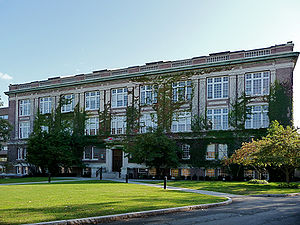
Greene Building, Rensselaer Polytechnic Institute
Encyclopedia

Rensselaer Polytechnic Institute
Stephen Van Rensselaer established the Rensselaer School on November 5, 1824 with a letter to the Rev. Dr. Samuel Blatchford, in which van Rensselaer asked Blatchford to serve as the first president. Within the letter he set down several orders of business. He appointed Amos Eaton as the school's...
(RPI). Named for Benjamin Franklin Greene, it has its own library for use by the architecture students. The second floor contains a gallery for students’ work, the basement third, and fourth floors contain multiple studios,open 24 hours a day for students and faculty to complete projects. The architecture library contains 30,000 books and 100,000-plus slides.http://www.rpi.edu/academics/resources/libraries.html
The basement floor now houses the wood shop. This state of the art shop includes a milling machine, two laser cutters, many wood working machines, and space for students to construct models.
History
The building was completed in 1931 at a cost of $400,000, shortly after the School of Architecture was founded. The building was named in memory of Benjamin Franklin Greene, Director of Rensselaer from 1847 to 1859. The names of fifteen of the most renowned deceased American architects were cut in stone above the second-story windows: BulfinchCharles Bulfinch
Charles Bulfinch was an early American architect, and has been regarded by many as the first native-born American to practice architecture as a profession....
, Burnham
Daniel Burnham
Daniel Hudson Burnham, FAIA was an American architect and urban planner. He was the Director of Works for the World's Columbian Exposition in Chicago. He took a leading role in the creation of master plans for the development of a number of cities, including Chicago and downtown Washington DC...
, Goodhue
Bertram Goodhue
Bertram Grosvenor Goodhue was a American architect celebrated for his work in neo-gothic design. He also designed notable typefaces, including Cheltenham and Merrymount for the Merrymount Press.-Early career:...
, Hooker
Philip Hooker
Philip Hooker was at one time the leading architect of New York State outside of New York City. He designed Hyde Hall, the facade of the Hamilton College Chapel, The Albany Academy, Albany City Hall, Hart-Cluett Mansion and the original New York State Capitol building. He is believed to have...
, Hunt
Richard Morris Hunt
Richard Morris Hunt was an American architect of the nineteenth century and a preeminent figure in the history of American architecture...
, Jefferson
Thomas Jefferson
Thomas Jefferson was the principal author of the United States Declaration of Independence and the Statute of Virginia for Religious Freedom , the third President of the United States and founder of the University of Virginia...
, Latrobe
Benjamin Latrobe
Benjamin Henry Boneval Latrobe was a British-born American neoclassical architect best known for his design of the United States Capitol, along with his work on the Baltimore Basilica, the first Roman Catholic Cathedral in the United States...
, McComb
John McComb Jr.
John McComb, Jr. was an American architect who designed many landmarks in the 18th and 19th centuries.McComb's father John McComb, Sr...
, McIntyre, McKim
Charles McKim
Charles McKim may refer to:*Charles Follen McKim , American Beaux-Arts architect*Charles M. McKim , American architect...
, Mills
Robert Mills (architect)
Robert Mills , most famously known for designing the Washington Monument, is sometimes called the first native born American to become a professional architect, though Charles Bulfinch perhaps has a clearer claim to this honor...
, Renwick
James Renwick, Jr.
James Renwick, Jr. , was a prominent American architect in the 19th-century. The Encyclopedia of American Architecture calls him "one of the most successful American architects of his time".-Life and work:Renwick was born into a wealthy and well-educated family...
, Richardson
Henry Hobson Richardson
Henry Hobson Richardson was a prominent American architect who designed buildings in Albany, Boston, Buffalo, Chicago, Pittsburgh, and other cities. The style he popularized is named for him: Richardsonian Romanesque...
, Sullivan
Louis Sullivan
Louis Henri Sullivan was an American architect, and has been called the "father of skyscrapers" and "father of modernism" He is considered by many as the creator of the modern skyscraper, was an influential architect and critic of the Chicago School, was a mentor to Frank Lloyd Wright, and an...
, and Upjohn
Richard Upjohn
Richard Upjohn was an English-born architect who emigrated to the United States and became most famous for his Gothic Revival churches. He was partially responsible for launching the movement to such popularity in the United States. Upjohn also did extensive work in and helped to popularize the...
.

